|
Enemy territory
First Time Out!
On 18 March, 1945,I was launched
from the USS ESSEX (CV-9) in a Corsair F4U along with eleven others.
Lt. J. J. Stevens led our division of four planes and I was his
wingman. The number three slot was filled by LtJg Ed Pappert with
Vern Coumbe on his wing.
|
| Our mission was to bomb and strafe
two Airfields on the island of Kyushu, Japan and return to the ship.
We were the second group to hit Kyushu and figured the Japs were
probably stirred up and waiting for us. We climbed out and leveled |
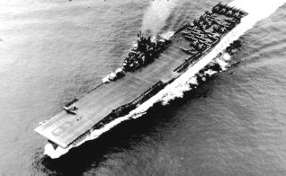
USS Essex CV9 |
| off at ten thousand feet. As we approached
the beach, I remember suddenly realizing the land we were looking
at was Enemy territory and the hairs on the back of my neck raised
right up. There was a |
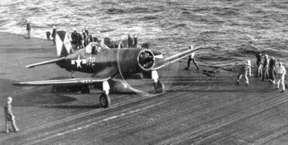 Coursair on Deck
Coursair on Deck |
broken layer of clouds beneath
us. Just as we crossed the shoreline I saw two planes below heading
in the opposite direction. Upon looking closer I identified them
as Jap Torpedo Bombers. Since we were
|
| on radio silence, I could only wave my hands
and signal to Steve, our Leader. I motioned to the left and he nodded
OK. We made a diving turn and as I leveled off, one of the Jap planes
was squarely in my sights. A squeeze of the trigger and the six
fifty-caliber guns literally tore the plane apart. It burst in to
flames and headed down. As the other one saw what was happening,
he dove for the water at full throttle and took off like a rabbit.
Steve hadn't fired a shot or made a sign as we turned back and rejoined
the formation. I thought about that |
|
for awhile and then the
thought came to me that "My God, I have shot down a US Navy
TBM." But then I said to myself, "I saw meat balls on
those planes so they had to be Japs." This was our very first
combat flight and we all were wound pretty tight. I also later
realized that leaving the formation was a violation
|
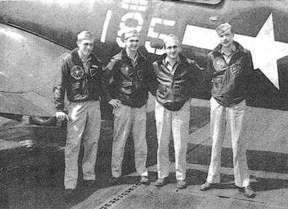 Coumbe, Pappert, Pat,(the Skipper) and
Wally. Division One
Coumbe, Pappert, Pat,(the Skipper) and
Wally. Division One |
| of the "Fighter Code" to never
leave the group. I don't remember the names of our two target airfields,
but when we arrived at the first one, there were no airborne aircraft
in sight. We proceeded to bomb and strafe parked planes, hangars,
and runways with no resistance except antiaircraft gunfire from
the ground. Then we headed for another airfield and gave it the
same treatment with the same results. By then we were pretty cocky,
seeing as how this business was so easy and fun too. We even opened
up on the radio (big mistake)! Our leader said, "What the hell,
lets hit another one on the way back," (another mistake)! Tomitaka
Airfield wasn't too far off course so we decided to work it over
too. What we didn't know was that 20 Zeros (Hamps & Zekes),
were sitting up at twenty thousand feet waiting for us. |
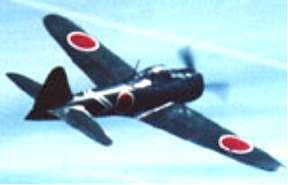 Zeke (Zero A6M5)
Zeke (Zero A6M5) |
"Hamp and Zeke" were
the US official nicknames for the Japanese A6M3 Type 32 Fighter
Plane. "Zero" was the unofficial nickname. We made our
approach to the airfield down a little valley and got rid of all
hanging ordnance on the first run — there was no second |
|
run! As we pulled up the air was suddenly
full of meat balls (Japs), and a wild dogfight ensued. We were
caught off guard and at low altitude.
Our standard fighter tactics wouldn't work
and it quickly evolved into a wild melee of tail chases —
a Zero chasing a Corsair with another Corsair chasing the Zero
etc. While our Leader (Steve), was shooting one, I was busily
knocking another one off his tail. As I flamed that
|
|
one, someone hollered that
one was on my tail. Sure enough I saw tracers whizzing by on both
sides, so I pulled up into a full-power, straight up, climb until
she stalled out and went into a spin. It was a given that one
does not intentionally
|
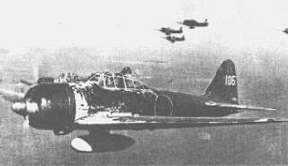
Zeke (Zero A6M5) |
|
spin a Bent Wing (Corsair), but to me it
felt really good until I recovered right back in the middle of
the dog fight. That's when I saw Steve's plane smoking and heading
out to sea in a shallow dive. I followed to keep the Zeros off
his back until he ditched and got out of the plane. I`m not sure
how many we got, but Pappert and Coumbe each flamed a Zeke and
Pappert also got a probable.
We lost three pilots that day, Stevens,
Garner and Sigman. Steve was in the water and swimming around
very slowly. Three of us circled him at low altitude with flaps
down and each of us threw him a spare life raft, which we all
carried. The other two planes finally left but I was reluctant
to leave my Flight Leader and kept circling to see if he got one
of the rafts, however he didn't even try to get one. I then managed
to remove the life raft from my seat parachute and while flying
very low and slow, pulled the inflation toggle and threw the raft
some distance upwind from him. It drifted right by him but he
didn't attempt
|
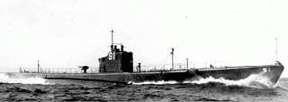
USS Salmon
|
to get it. We had
been briefed on the location of the Standby Rescue Submarine so
I looked it up on the map and noticed that this one's code name
was |
|
"Pal Joey." Approaching the location,
I saw it on the surface with a big American Flag flying and some
of the Crew on deck. I couldn't make radio contact, so in accordance
with prescribed procedures, I lowered the landing gear and flew
over in the direction of Lieutenant Stevens. They understood,
gave a big wave and headed out on that course — still on
the surface! I was impressed by their bravery doing that when
so close to enemy shores.
By this time it was getting late so I plotted
a course to the ship and headed home. They were waiting for me
so they could get me aboard and head out of the wind. As I hit
the deck, the Bull Horn squawked for me to report to the Bridge
and explain what I had been doing. That was my first combat flight
and my "Baptism of Fire," so to speak.
|
|
Next day we did it
all over again on another mission and, in addition, saw USS Franklin,
CV-13, burning in the water on our way home. This was to be our
steady diet for the next five months.
|
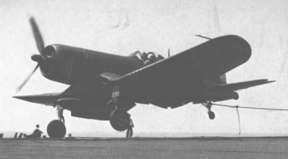
07-Arrested landing |
|
The Air
Group, (CVG-83), flew 9,982 sorties from USS ESSEX for 39,500
hours in the air. We destroyed 228 Jap planes in the air, with
121 probables and 107 on the ground. We also participated in the
sinking or damaging of 265,000 tons of combat vessels, (including
the Battleship Yamato), and 77,000 tons of merchant shipping.
If we appeared to take death lightly it was because it was necessary
to keep from going crazy. When seeing our shipmates being killed
day after day, we tried to build up an immunity to it, sort of
a defensive shell. 35 pilots and 13 aircrewmen were lost before
we would return to the US of A and go ashore at the Naval Air
Station, Seattle, Washington, on 14 September 1945. "To make
the world safe for Democracy."
LTJG Glen (Wally) Wallace.
In 1990, I received the following note from
Henry Sakaida, a Japanese Author who sent me a story about the
Kamikaze entitled: "THUNDER GODS, The Kamikaze tell their
story." Written by Hatsuho Naito, translated by Mayumi Ichikawa
and forwarded by James Michener.
|
| ............. |
|
Capt. Wallace -
The Japanese side of your air raid!
If the information here is accurate, then it appears that
you downed UMENO. It also appears that UMENO and possibly
TANIMIZU attacked Lt. J.J. STEVENS, with Umeno causing Stevens
to smoke and Tanimizu then chasing him out to sea.
HENRY SAKAIDA
|
|
............. |
Send Corrections, additions, and
input to:
WebMaster/Editor

|